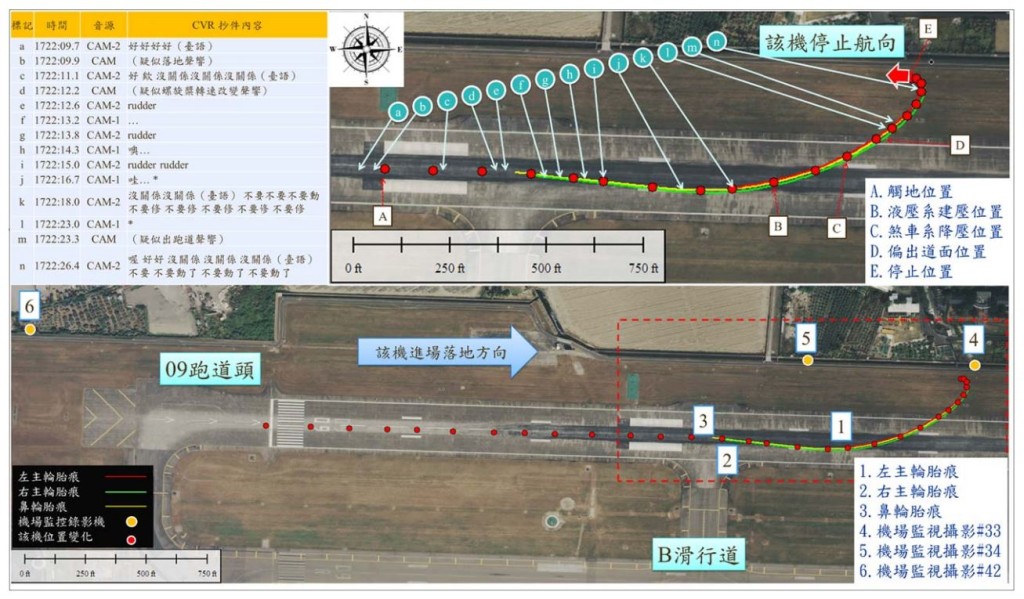Twin Otter Nose Wheel Steering Misused in Runway Excursion
On 23 April 2018, Daily Air‘s flight DA7012, a Viking DHC-6-400 Twin Otter, B-55573, departed Qimei Airport for Kaohsiung International Airport. According to the Taiwan Aviation Safety Council (ASC) safety investigation report (only available in full in Chinese) the aircraft landed at Kaohsiung:
…in a right crosswind. After touchdown, the pilot flying (PF) attempted to correct the lateral deviation but misused the nose wheel steering lever which caused the aircraft veered-off the runway from its left hand side with a 35 degrees drift angle.
The aircraft turned 180 degrees left and stopped on the grass area.
The aircraft commander was PF.
ASC Safety Analysis
The ASC made 10 findings related to risk, 8 of which are reproduced below in full:
- At the time of the occurrence, the DHC-6-400 level D flight simulator was not yet available in the aviation industry. The Daily Air could only carry out pilot training and check in a real aircraft. However, it is not only impossible to simulate various scenarios and weather conditions in a real aircraft, but also contained higher risks, thus restricted the effectiveness of pilot training and check.
- Daily Air did not specify standard call-outs in relevant manuals for pilot monitoring (PM) to remind lateral deviation during landing roll. Thus the flight crew acted on their own style and it weakened the effectiveness and accuracy of the communication.
- Daily Air did not specify the timing or speed limit in relevant manuals for the use of “nose wheel steering”. It may result in divergence of views and actions toward this issue and adverse effect on standardization in the DHC-6-400 fleet.
- Daily Air did not have a clear policy regarding the usage of asymmetric thrust to assist directional control during landing roll. There were divergences in opinions between management, instructor pilots, check airmen and flight crew in the DHC-6-400 fleet.
- The captain of this occurrence had already carried out all flying tasks, including take-off and landing operations manually for 8 legs, and his flight duty period had exceeded 10 hours. The captain’s decayed physical and mental conditions due to his accumulated workload could weaken his alertness and ability to perform tasks safely.
- Although flight crew schedules of Daily Air was in compliance with the CAA regulations, a bio-mathematical model analysis of pilot fatigue showed that the eastern Taiwan routes with 12 legs a day may exist a high risk of fatigue, the Taiwan eastern routes with 10 legs a day may exist a moderate-to-high risk of fatigue; the western Taiwan routes with 8 legs a day may exist a moderate risk of fatigue.
- Shortage of pilots in Daily Air DHC-6-400 fleet has existed at least for a year before the occurrence happened, especially in the case of a shortage of captains, which may result in high risk of fatigue on the pilot flight schedule.
- The cockpit of DHC-6-400 aircraft owned by Daily Air was not equipped with effective air-conditioning, which may result in unpleasant mental situation or fatigue of flight crew members due to potentially heat stress environment.
There were also two rather vague findings on the airline’s “internal evaluation program” (IEP). One that the IEP was spread across the Safety Management Manual and the other that flight crew recurrent checks were included in the IEP. While both might be symptoms of weaknesses in the SMS neither are linked directly to a noteworthy risk in the report.
Safety Recommendations
Recommendations to Daily Air :
- Integrate relevant flight manuals of the DHC-6-400 fleet to contain standard call-outs for lateral deviation during landing roll, specific timing and speed limitation for the usage of nose wheel steering … etc, so that the flight crew operation and training can be standardized and the flight safety can be promoted.
- Expedite the process of training program on DHC-6-400 level D simulator to strengthen the flight crew training and check for crosswind landing.
- Review and improve the shortage of the DHC-6-400 flight crew and the cockpit environment. And identify high fatigue risks from the pilot flight schedule patterns to revise schedule rules or strengthen the fatigue management mechanisms to mitigate pilot fatigue.
- Refer to the advisory circular F120-59A “Air Carrier Internal Evaluation Programs” issued by Taiwan CAA. Review, strengthen, and integrate the internal evaluation programs for each units at Daily Air.
Recommendations to Civil Aeronautics Administration, Ministry of Transportation and Communications :
- Supervise Daily Air on integrating relevant flight manuals of the DHC-6-400 fleet to standardize flight crew operation and training, request the compliance with procedures, so as to improve the flight safety.
- Supervise Daily Air on expediting the process of training program on DHC-6-400 level D simulator to strengthen the flight crew training and check for crosswind landing.
- Supervise and assist Daily Air improving its flight crew cockpit environment, workload and fatigue managements, flight crew manpower management and internal evaluation programs.
Safety Resources
On error management:
…and our review of The Field Guide to Understanding Human Error by Sidney Dekker presented to the Royal Aeronautical Society (RAeS): The Field Guide to Understanding Human Error – A Review
- G200 Leaves Runway in Abuja Due to “Improper” Handling
- Gripen Main Landing Gear Damaged During Unstabalised Short Field Landing
- Runway Excursion Exposes Safety Management Issues
- CRJ900 Skids Sideways Down Finnish Runway
- AAIB: Human Factors and the Identification of Saab 2000 Flight Control Malfunctions
- Procedural Drift at Saab 340 Operator Leads to Taxiway Excursion
- Gulfstream G-IV Take Off Accident & Human Factors
- Confusion of Compelling, But Erroneous, PC-12 Synthetic Vision Display
- C-130J Control Restriction Accident, Jalalabad
- Easyjet A320 Flap / Landing Gear Mis-selections
- Premature A319 Evacuation With Engines Running
- UPDATE 4 October 2020: Investigators Suggest Cultural Indifference to Checklist Use a Factor in TAROM ATR42 Runway Excursion



Recent Comments